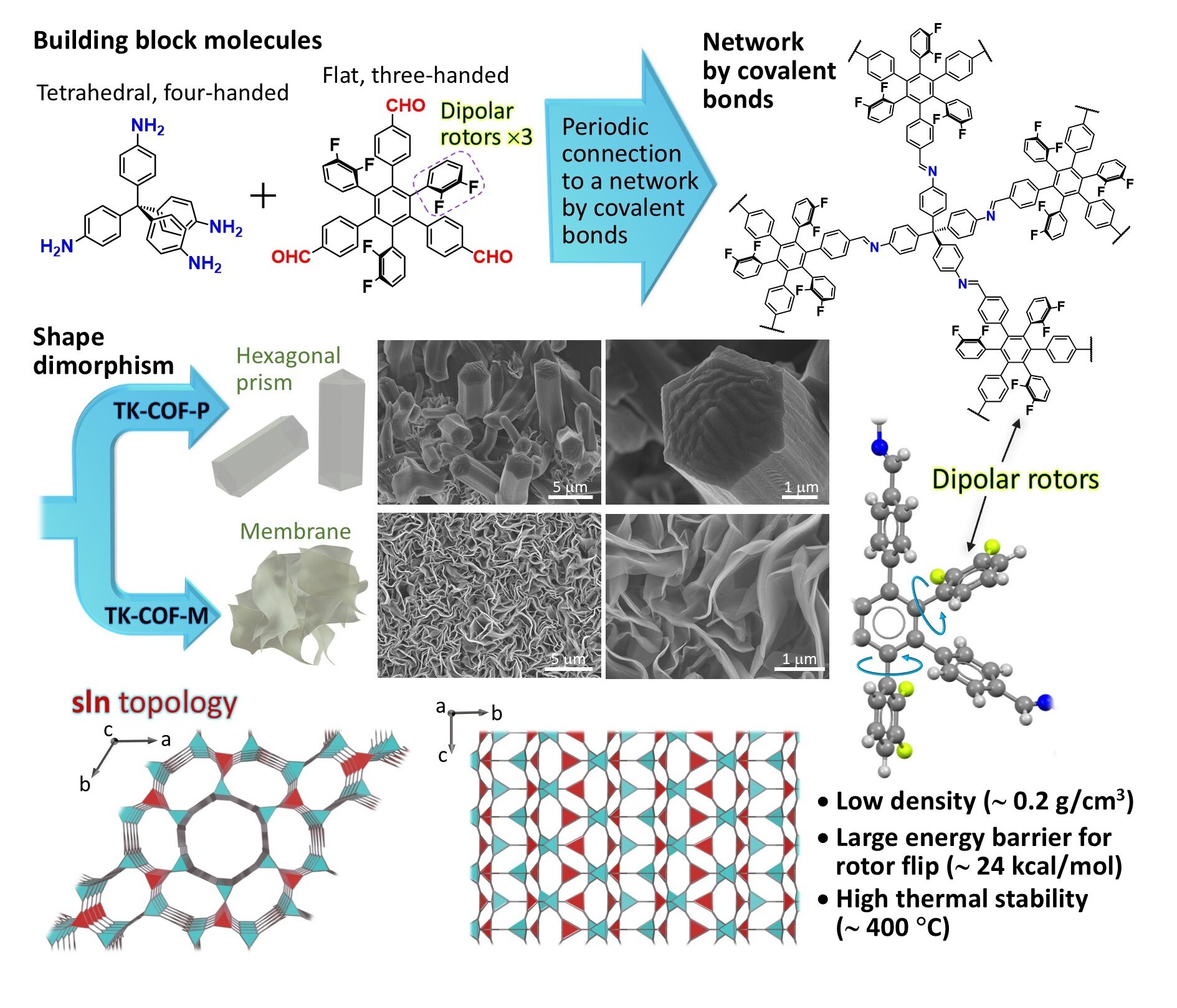Tech
New non-volatile memory platform built with covalent organic frameworks

Researchers at Institute of Science Tokyo have created a new material platform for non-volatile memories using covalent organic frameworks (COFs), which are crystalline solids with high thermal stability. The researchers successfully installed electric-field-responsive dipolar rotors into COFs.
Due to the unique structure of the COFs, the dipolar rotors can flip in response to an electric field without being hampered by a steric hindrance from the surroundings, and their orientation can be held at ambient temperature for a long time, which are necessary conditions for non-volatile memories. The study is published in the Journal of the American Chemical Society.
Humans have made great efforts to record information by inventing recording media such as clay, paper, compact disks, and semiconductor memories. As the physical entity that holds information—such as indentations, characters, pits, or transistors—becomes smaller and its areal density becomes higher, the information is stored with higher density. In rewritable memories, the class called “non-volatile memories” are suitable for storing data for a long time, such as for days and years.
Recently, molecular technology has evolved. One class of molecular technology consists of molecules that exhibit mechanical motions. They are called “molecular machines” or “nanomachines.” If a mechanical entity rotates or flips around a chemical bond, which serves as an axis, the material class is particularly called “molecular rotors.”
Use of molecular rotors to store information may cause a breakthrough. This is because the size of molecules is a few orders of magnitude smaller than the sizes of pits in a compact disk and transistors in semiconductor memories, and organic molecules are inherently highly designable. Although applications using molecular machines have been explored extensively, the attempts to develop non-volatile memories have been scarce, mainly because the simultaneous satisfaction of the following three requisites has been so challenging.
- To control the orientation of molecular rotors with an electric field, the rotors have to have a dipole—a spatial displacement of a positive charge and a negative charge necessary to gain a force from the applied electric field.
- The rotors must not flip at ambient temperatures so that their orientations are held for a long period.
- There must be adequate spaces around the rotors so that they can flip without being hampered by the steric hindrance that may be caused by the tight packing of the molecules in the solid phase. Additionally, the substance has to be heat durable up to the temperatures current computational components ordinarily undergo, which is often up to 150°C.
New materials developed by the researchers of Institute of Science Tokyo have achieved these three requisites simultaneously, with very high thermal durability up to near 400°C. By demonstrating these novelties for the first time, the researchers have created a material foundation for molecular-machine-based non-volatile memories that potentially store information at higher density than current technologies.
The researchers selected covalent organic frameworks (COFs) as a platform for the aim. COFs are an emerging class of crystalline solids formed by periodically connecting two kinds of building block molecules by covalent bonds. For one building block, they chose a tetrahedral, four-handed molecule. For the other building block, they newly developed a flat, three-handed molecule in which three dipolar rotors (1,2-difluorophenyl, DFP) and three aryl groups are alternately positioned around the central benzene ring.
Previously, these aryl groups were shown to suppress the flip of the DFP rotors at ambient temperatures in a toluene solution, which satisfied requisites 1 and 2 above, but the high density of the molecular solid sterically hindered the flip of the rotors in the solid phase, which could not satisfy requisite 3.
Interestingly, the COFs they developed exhibited an unprecedented shape dimorphism, in which the COFs grew to a hexagonal prism shape or a membrane shape, depending on the solvent composition used for the growth. Furthermore, from X-ray structural analyses, these new COFs turned out to have an unprecedented sln topology, which has a low density inherently and has not been reported for COFs.
“Due to the substantially low density of about 0.2 g/cm3 caused by the unique sln topology possessed by the COFs, the dipole rotors incorporated into the periodic network constituting the COFs have adequate spaces around them, allowing them to flip without suffering from the steric hindrance from their surroundings.
“This is a breakthrough, because our COFs are a rare solid in which dipolar rotors can flip when they are brought to elevated temperatures above 200°C or undergo sufficiently strong electric fields, but their orientations can be held for a long time at ambient temperatures. These uniquenesses have been realized by our careful selection of the building block molecules to create the COFs for this aim,” says Professor Yoichi Murakami, the leader of this project.
Additionally, Murakami pointed out the significance of the work also exists in the extension of the diversity of COFs by their discoveries of sln topology and shape dimorphism, both of which were unknown for COFs previously.
These COF-based solids may be a new platform for storing information with further higher density after proper scale-up and device demonstration are made subsequently.
More information:
Xiaohan Wang et al, sln-Topological Covalent Organic Frameworks with Shape Dimorphism and Dipolar Rotors, Journal of the American Chemical Society (2025). DOI: 10.1021/jacs.5c10010
Citation:
New non-volatile memory platform built with covalent organic frameworks (2025, September 5)
retrieved 5 September 2025
from https://techxplore.com/news/2025-09-volatile-memory-platform-built-covalent.html
This document is subject to copyright. Apart from any fair dealing for the purpose of private study or research, no
part may be reproduced without the written permission. The content is provided for information purposes only.
Tech
Top Vimeo Promo Codes and Discounts This Month in 2025

Remember Vimeo? You probably don’t use it to browse videos the way you might with some other services. But if you landed on this page, there’s a good chance you use it to host your professional portfolio. Or assets for your business. Or your short films. Vimeo has tools other video hosting services simply don’t have, like AI editing tools, on-demand content selling, customizable embeds, and collaborative editing features. And best of all: There are no ads. WIRED has rotating Vimeo promo codes to help you save.
Get 10% Off Annual Plans With This Vimeo Promo Code
No matter what you need for your business or career, when it comes to video, Vimeo’s got multiple plans to suit. And luckily, right now, you can save with a Vimeo promo code—even on the annual plans, which already include 40% in savings. Just use Vimeo coupon code GETVIMEO10 to save 10% on your membership plan.
The Easiest Way to Save 40% on Your Vimeo Plan
Vimeo has a few different membership plans that you can save on. No matter which you go with, the easiest way to save a lot is with an annual membership, which has automatic 40% savings compared to paying monthly. And yes, you can even stack promo codes with the annual billing options.
More on Vimeo Pricing and Membership Plans
So what tier do you need? The Starter plan starts at $12 per month (billed annually) or $20 per month (billed monthly). It comes with 100 gigabytes of storage, plus boosted privacy controls, custom video players, custom URLs, and automatic closed captioning.
Boost your plan to Standard for $25 per month (billed annually) or $41 per month (billed monthly) to upgrade to 2 terabytes of storage, 5 “seats” (which are collaborative team member spots), a brand kit, a teleprompter, text-based video editing, AI script generation, and engagement and social analytics.
Finally, there’s the Advanced plan, which costs $75 per month (billed annually) or $125 per month (billed monthly). You’ll get 10 “seats”, 7 terabytes of storage, AI-generated chapters and text summaries, live chat and poll options, plus streaming and live broadcast capabilities.
Use a Vimeo Coupon Code to Get Savings on Vimeo on Demand
Vimeo on Demand is a new way to stream and download movies online. Through Vimeo on Demand, you can rent, buy and subscribe to the best original films, documentaries and series directly from your favorite small business video creators, including The Talent and Wild Magic.
Vimeo Enterprise Solutions 2025
You may have not heard about Vimeo Enterprise, but it’s probably the most essential program for content creators, videographers, and digital media in the workplace in general. From meeting recordings and AI-driven video creation to compliance and distribution, Vimeo Enterprise helps centralize and manage video workflows.
Does Vimeo Have a Free Trial?
While Vimeo doesn’t have a free trial of its paid plans, it does have a free plan with some basic features. Additionally, paid plans can be canceled anytime–within 14 days for an annual subscription, or 3 days for a monthly subscription. You’ll get a full refund if you decide to cancel within the respective timeframes.
Tech
WIRED Roundup: DOGE Isn’t Dead, Facebook Dating Is Real, and Amazon’s AI Ambitions

Leah Feiger: So it’s a really good question actually, and it’s one that I’ve thought about for quite some time. I think if it’s not annoying, I want to read this quote from Scott Kupor, the director of OPM and the former managing partner at Andreessen Horowitz, to be clear, just to remind everyone where people are coming from in this current administration. He posted this on X late last month, and this was part of Reuter’s reporting. So he posts, “The truth is, DOGE may not have centralized leadership under USDS anymore, but the principles of DOGE remain alive and well, deregulation, eliminating fraud, waste and abuse, reshaping the federal workforce, et cetera, et cetera, et cetera.” Which is the exact same, the thing that they’ve been saying this entire time, but it’s all smoke and mirrors, right? It’s like, oh no, no, well, DOGE doesn’t exactly exist anymore. There’s no Elon Musk character leading it, which Elon Musk himself said on the podcast with Joe Rogan last month as well. He’s like, “Yeah, once I left, they weren’t able to pick on anyone, but don’t worry, DOGE is still there.” So it feels wild to watch people fall for this and go like, “DOGE is gone now.” And I’m like, they’re literally telling us that it’s not.
Zoë Schiffer: I think one thing that does feel honestly true is that it is harder and harder to differentiate where DOGE stops and the Trump administration begins because they have infiltrated so many different parts of government and the DOGE ethos, what you’re talking about, deregulation, cost cuttings, zero-based budgeting, those have really become kind of table stakes for the admin, right?
Leah Feiger: I think that’s such a good point. And honestly, by the end of Elon Musk’s reign, something that kept coming up wasn’t necessarily that the Trump administration didn’t agree with DOGE’s ethos at all. It was that they didn’t really agree with how Musk was going about it. They didn’t like that he was stepping on Treasury Secretary Scott Bessent and having fights outside of the Oval Office. That was bad optics and that also wasn’t helping the Trump administration even look like they were on top of it.
Tech
Horses, the Most Controversial Game of the Year, Doesn’t Live Up to the Hype

The debate over Horses’ delisting is emblematic of a bigger fight that’s taken place this year, when platforms such as Steam and Itch.io yanked down “NSFW” and “porn” games in July. Developers, players, and trade organizations have continued to be vocal about developers’ creative rights to make games that deal with adult content.
“Developers shouldn’t have to compromise their creative vision, but we also have to acknowledge that games exist within capitalist structures where access to platforms determines livelihood,” says Jakin Vela, executive director of the International Game Developers Association, a nonprofit supporting game developers. “The key is informed decision-making and understanding what each platform allows, what risks exist, and whether your artistic goals outweigh those risks.”
Still, Vela says, these removals have exposed the fragility of developers’ economic security. “We should be concerned whenever a system allows a creator’s livelihood to be cut off without transparency or recourse,” he says. The video game industry is highly consolidated, with a handful of platforms controlling access to the vast majority of players. “That imbalance creates a structural issue, not necessarily because platforms enforce rules, but because there are so few viable alternatives.”
Santa Ragione’s future should not hinge on its ability to exist on Steam or any other platform. A bad project should not spell the end of a developer who is, for all the criticisms I have of its game, trying to say something. That part of this story may still yet have a happy, or at least a survivable, ending. The Streisand effect is paying off for Horses. On the digital distribution platform GOG, where it’s still available, the game is a top-seller.
Horses needs to be defended against censorship. It is also a bad game that should be examined as such. But while the conversation around Horses is still stalling out about why the game is allowed to exist, or how it’s not that offensive, the better question is why we really care about it at all—and why, as players, we feel so reluctant to talk about its failings like any other piece of media.
-

 Sports5 days ago
Sports5 days agoIndia Triumphs Over South Africa in First ODI Thanks to Kohli’s Heroics – SUCH TV
-

 Tech6 days ago
Tech6 days agoGet Your Steps In From Your Home Office With This Walking Pad—On Sale This Week
-

 Fashion5 days ago
Fashion5 days agoResults are in: US Black Friday store visits down, e-visits up, apparel shines
-

 Entertainment5 days ago
Entertainment5 days agoSadie Sink talks about the future of Max in ‘Stranger Things’
-

 Politics5 days ago
Politics5 days agoElon Musk reveals partner’s half-Indian roots, son’s middle name ‘Sekhar’
-

 Tech5 days ago
Tech5 days agoPrague’s City Center Sparkles, Buzzes, and Burns at the Signal Festival
-

 Sports5 days ago
Sports5 days agoBroncos secure thrilling OT victory over Commanders behind clutch performances
-

 Entertainment5 days ago
Entertainment5 days agoNatalia Dyer explains Nancy Wheeler’s key blunder in Stranger Things 5


















